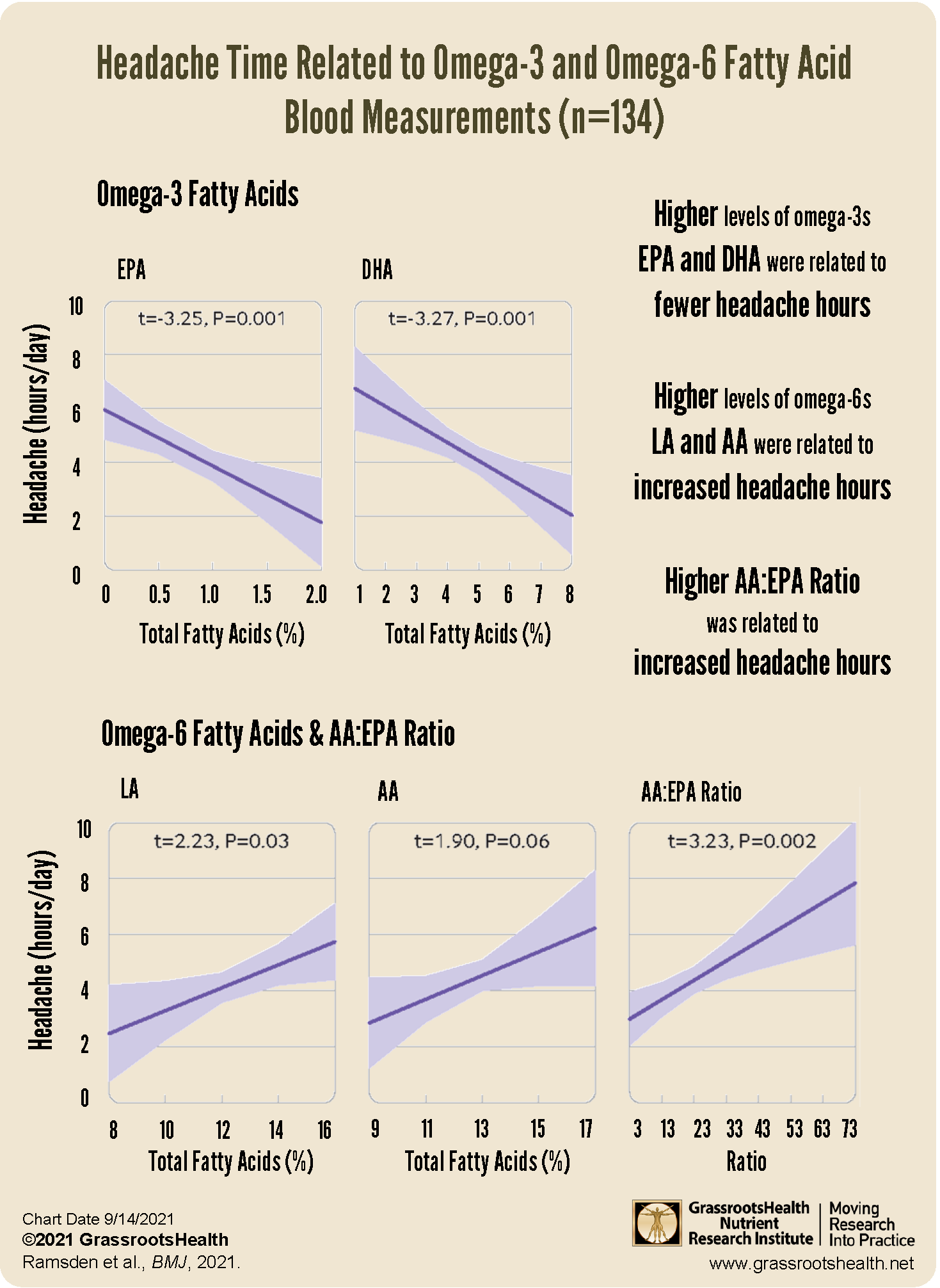Published on September 15, 2021
A study on migraines concludes that increased intake and blood levels of omega-3 fatty acids may help reduce headaches for migraine sufferers
Key Points
- Nutrients such as magnesium, vitamin D, and omega-3s have been shown to help improve migraine symptoms
- Increasing levels of anti-inflammatory omega-3 fatty acids (such as EPA and DHA) and decreasing levels of pro-inflammatory omega-6 fatty acids (such as LA and AA) could be a way to help reduce inflammation and pain in several chronic diseases, including migraines
- Migraine sufferers receiving 1.5 mg/day of EPA+DHA in their diet for 16 weeks had significantly decreased frequency and severity of headaches compared to the control group
- Higher blood levels of EPA and DHA were significantly related to less time with a headache per day, while higher levels of LA and a higher AA:EPA Ratio were significantly related to more time with a headache per day

Migraines are among the most common chronic diseases worldwide, with many migraine sufferers experiencing high levels of pain and even disability, despite the use of medications. Studies have shown that some nutrients, including vitamin D and magnesium, can help relieve migraine symptoms and reduce their frequency. A 2016 meta-analysis of 21 studies found that intravenous magnesium significantly alleviated acute migraine symptoms by about 75% both immediately (15-45 minutes) and longer term (24 hours). Oral magnesium, used for migraine prevention, was found to significantly reduce the frequency of migraines by 80% and the intensity of migraines by 78%.
Omega-3 fatty acids might also help with migraines. We have previously discussed how omega-3 and omega-6 fatty acids work together to directly regulate inflammation, immune function, and pain. It is also known that omega-3 and omega-6 fatty acids are a major component of the tissues involved; for example, the omega-3 fatty acid DHA makes up approximately 8% of the weight of the brain!
What Are Omega-3 and Omega-6 Fatty Acids?
Omega-3 and omega-6 fatty acids are two types of “essential” fatty acids that must be obtained through the diet. Eicosapentaenoic acid (EPA) and eocosahexaenoic acid (DHA) are the two main omega-3 fatty acids. The most common omega-6 fatty acid is linoleic acid (LA), which is converted into longer omega-6 fats such as arachidonic acid (AA).
Omega-3s and omega-6s in the cell membrane play different roles, especially in inflammation. Omega-6s (such as AA) are pro-inflammatory, essential for initiating and sustaining the inflammatory response – a physiologic function necessary for healing from injuries and infection. Omega-3s (such as DHA and EPA) are anti-inflammatory and promote the resolution of the inflammatory process. The Standard American Diet tends to provide less than 150 mg/day of EPA and DHA, with the intake of linoleic acid at around 7% of energy. This can lead to an abundance of pro-inflammatory omega-6s in the cell membranes, and in turn, increases the risk of inflammation and chronic conditions and diseases related to inflammation.
For more on the differences between omega-3s and omega-6s, their roles in health, and what foods provide each, visit this blog.
Could Omega-3s and Omega-6s Help Reduce Migraines?
A study by Ramsden et al. looked at the effect of omega-3 and omega-6 fatty acid intake and levels on headaches in adults who suffered from migraines. The study involved 182 participants with an average age of 38 years, who suffered migraines 5 to 20 days per month; 88% of the participants were women, and 67% met the criteria for having a chronic migraine diagnosis.
The study authors designed three different diets to be given to the participants for a total of 16 weeks.
- High Omega-3 (H3) diet (n=61): increased EPA+DHA intake to 1.5 g/day
- High Omega-3/Low Omega-6 (H3-L6) diet (n=61): increased EPA+DHA intake to 1.5 g/day with LA intake decreased to 1.8% or less of energy intake
- Control diet (n=60): average US intake of omega-3 and omega-6 fatty acids – less than 150 mg/day of EPA and DHA, with LA intake of around 7% of energy
All participants answered a daily questionnaire regarding headache frequency and severity; blood levels of EPA, DHA, LA, AA, AA:EPA Ratio, and specific pain-mediating byproducts of each of these fatty acids were measured and tracked.
Intake and Levels of Omega-3s and Omega-6s Shown to Significantly Affect Migraines
At the beginning of the study, participants indicated an average of 16.3 headache days per month and 5.4 headache hours per day. At the end of the 16 weeks, those on the H3-L6 and H3 diets had significantly decreased frequency and severity of headaches compared to the control group. Average headache hours at the end of the study were
- 4.9 hours for participants on the control diet
- 3.6 hours for participants on the H3 diet
- 3.2 hours for participants on the H3-L6 diet
In addition, the H3-L6 group had 4 fewer headache days per month than the control group at the end of the study, and 2 fewer headache days than the H3 group.
Improved blood levels of EPA+DHA were seen with both the H3 and H3-L6 diets, as well as significantly decreased blood levels of LA and AA. As illustrated in the charts above, participants experienced fewer hours of headache per day as blood levels of EPA and DHA increased (p=0.001) and as LA and the AA:EPA ratio decreased (p=0.03, p=0.002).
Measure Your Levels of Omega-3s and Omega-6s
GrassrootsHealth offers several testing options to help measure levels of omega-3 and omega-6 fatty acids – the Omega-3 Index, AA:EPA Ratio, and Omega-6:Omega-3 Ratio. Learn more about these tests and the differences between them here. More information on how to improve these test results can be found here.
Remember to Check Important Co-Nutrients as Well
 Having and maintaining healthy vitamin D levels and other nutrient levels can help improve your health now and for your future. Choose which to measure, such as your vitamin D, omega-3s, and essential minerals including magnesium and zinc, by creating your custom home test kit today. Take steps to improve the status of each of these measurements to benefit your overall health. You can also track your own intakes, symptoms and results to see what works best for YOU.
Having and maintaining healthy vitamin D levels and other nutrient levels can help improve your health now and for your future. Choose which to measure, such as your vitamin D, omega-3s, and essential minerals including magnesium and zinc, by creating your custom home test kit today. Take steps to improve the status of each of these measurements to benefit your overall health. You can also track your own intakes, symptoms and results to see what works best for YOU.
Enroll and test your levels today, learn what steps to take to improve your status of vitamin D (see below) and other nutrients and blood markers, and take action! By enrolling in the GrassrootsHealth projects, you are not only contributing valuable information to everyone, you are also gaining knowledge about how you could improve your own health through measuring and tracking your nutrient status, and educating yourself on how to improve it.
Help everyone Move Research into Practice with vitamin D and other nutrients! As a special birthday gift to everyone, in honor of the science, we have created a special scholarship fund for anyone to donate to that will go towards helping others participate. Your donation will allow anyone to get help with funding their participation when they need it.
Text-to-give: Text Daction to 44321 to add to our Scholarship Fund.


 Click to Enlarge & Print
Click to Enlarge & Print


